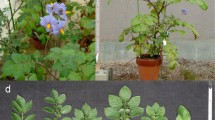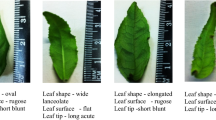Summary
Lotus comiculatus L. is a widely cultivated, outbreeding, leguminous forage crop. Seventy-one plants, most of which were tetraploid, were regenerated from calli derived from a single protoplast. Their morphological and agronomic traits were evaluated and compared with those of the seed-produced population. The variances of most of the traits in the protoplast-derived (protoclonal) population were smaller than those of the seed-produced population. Mean values of all the traits of the protoclonal population shifted significantly towards lower values. However, new phenotypic variants with higher values than those of the plant initially used for protoplast isolation were also observed. Plants with less hydrocyanic acid (which has a toxic effect on cattle) than the initial plant were obtained in the protoclones. Generally, the pollen fertility of protoclones was significantly low compared with the seed-produced plants. This seems to be partly due to the occurrence of abnormalities in chromosome structure during protoplast and/or callus culture, as suggested by the formation of univalents, lagging, and fragment chromosomes and bridges at metaphase I and anaphase I and II of the regenerants. The changes in chromosome structure, however, did not induce any malformed morphologies.
Similar content being viewed by others
References
Ashmore SE, Shapcott AS (1989) Cytogenetic studies of Haplopappus gracilis in both callus and suspension cell cultures. Theor Appl Genet 78:249–259
Bingham ET, McCoy TJ (1986) Somaclonal variation in alfalfa. In: Janick J (ed) Plant breeding reviews, vol 8. AVI, Westport, Conneticut pp 123–152
Damiani F, Mariotti D, Pezzotti M, Arcioni S (1985) Variation among plants regenerated from tissue culture of Lotus corniculatus L. Z Pflanzenzuecht 94:332–339
Gavazzi G, Tonelli C, Todesco G, Arreghini E, Raffaldi F, Vecchio F, Barbuzzi G, Biasini MG, Sala F (1987) Somaclonal variation versus chemically induced mutagenesis in tomato (Lycopersicon esculentum L.). Theor Appl Genet 74:733–738
Gill BS, Kam-Morgan LNW, Shepard JF (1987) Cytogenetic and phenotypic variation in mesophyll cell-derived tetraploid potatoes. J Hered 78:15–20
Grant WF, Sidhu BS (1967) Basic chromosome number, cyanogenetic glucoside variation, and geographic distribution of Lotus species. Can J Bot 45:639–647
Groose RW, Bingham ET (1984) Variation in plants regenerated from tissue culture of tetraploid alfalfa heterozygous for several traits. Crop Sci 24:655–658
Johnson LB, Stuteville DL, Schlarbaum SE, Skinner DZ (1984) Variation in phenotype and chromosome number in alfalfa protoclones regenerated from nonmutagenized calli. Crop Sci 24:948–952
Kao KM, Michayluk MR (1975) Nutritional requirements for growth of Vicia hajastana cells and protoplasts at a very low population density in liquid media. Planta 126:105–110
Lapitan NLV, Sears RG, Gill BS (1984) Translocations and other karyotypic structural changes in wheat x rye hybrids regenerated from tissue culture. Theor Appl Genet 68:547–554
Larkin PI, Scowcroft WR (1981) Somaclonal variation — a novel source of variability from cell cultures for plant improvement. Theor Appl Genet 60:197–214
McCoy TJ, Phillips RL, Rhines HW (1982) Cytogenetic analysis of plants regenerated from oat (Avena sativa) tissue cultures: high frequency of partial chromosome loss. Can J Genet Cytol 24:37–50
Murashige T, Skoog R (1962) A revised medium for rapid growth and bioassays with tobacco tissue cultures. Physiol Plant 15:473–497
Niizeki M, Saito K (1986) Plant regeneration from protoplasts of birdsfoot trefoil, Lotus corniculatus L. Jpn J Breed 36:177–180
Nishibayashi S, Kaeriyama J (1986) Structural stability of chromosomes in rice (Oryza sativa L.) plants regenerated from somatic tissue culture. Plant Tiss Cult Lett 3:31–34
Nitsch JP, Nitsch C (1969) Haploid plants from pollen grains. Science 163:85–87
Secor GA, Shepard JF (1981) Variability of protoplast-derived potato clones. Crop Sci 21:102–105
Snow R (1963) Alcoholic hydrochloric acid-carmine as a stain for chromosomes in squash preparations. Stain Technol 38:9–13
Author information
Authors and Affiliations
Additional information
Communicated by K. Tsunewaki
Rights and permissions
About this article
Cite this article
Niizeki, M., Ishikawa, R. & Saito, K. Variation in a single protoplast- and seed-derived population of Lotus corniculatus L.. Theoret. Appl. Genetics 80, 732–736 (1990). https://doi.org/10.1007/BF00224185
Received:
Accepted:
Issue Date:
DOI: https://doi.org/10.1007/BF00224185




